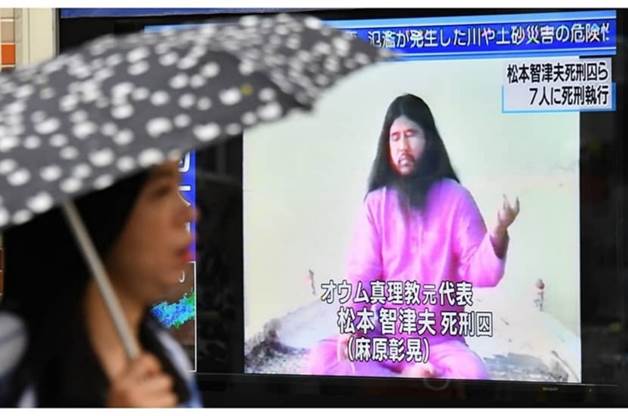
It is now 26 years since the doomsday cult known as Aum Shinrikyu (‘supreme truth’) carried out the worst domestic terrorist attack in Japanese history. Led by their leader Shoko Asahara, Aum released sarin gas on to the Tokyo subway, killing 13 and injuring 6,000. It remains the only time a weapon of mass destruction has been deployed by a private organisation. The details were sickening: one woman had to have her eyes surgically removed because the nerve gas fused her contact lenses on to them.
Despite Asahara’s execution in 2018, the death cult has (somehow) survived, changing its name to Aleph and spawning two splinter groups. Aleph is small but appears to be in rude health, with 1,650 members, considerable cash reserves and several properties. It reportedly attracts hundreds of recruits, mostly young men, every year.
Last week, Aleph was suspended as an organisation after refusing to hand over information about its assets to the Public Security Intelligence Agency. The order bans it from using its own facilities, recruiting new members, obtaining land and buildings and receiving donations, for six months.
It’s unclear how similar Aleph is to Aum. But it is staggering to many here in Japan that an offshoot of a murderous doomsday cult is still in business, and even growing. The cults are something of a diagnostic tool for the health of Japanese society: their existence proves that Japan’s problems aren’t being remedied by traditional institutions.
Understanding the complex yet enduring appeal of cults in Japan requires historical background. When emperor worship came to an abrupt halt at the end of the second world war, it created a vacuum into which came the first significant wave of new religious groups. Religious organisations were given tax exemptions which, in a time of great financial hardship, also made them attractive.
A second wave of religious cults arrived in the ‘bubble’ era of the 1970s and 1980s. Easy money and a dizzying pace of change upset the natural order. Society drifted towards amorality and decadence. The lonely, disorientated out-of-towners who had been lured to the big city by the booming economy were easy targets. Gurus offered them a sense of belonging and spiritual succour. This was the fertile ground within which Aum grew.
Aum’s appeal was more specialised than other cults. It recruited from the elite: Tokyo university graduates, lawyers, doctors and businessmen, who, perhaps burdened by the guilt of their success in life, were persuaded to hand over wealth to a charismatic messiah offering salvation from an imminent apocalypse. The leader was an obvious fraud. Asahara began his career peddling a snake oil known as Almighty Medicine (in fact just tangerine peel in alcohol) for $7,000 a shot to the terminally ill. George Orwell, who said that ‘some ideas are so stupid that only intellectuals believe them’, might have recognised the dynamic.
Many heavyweight Japanese writers, from Haruki Murakami to Kenzaburo Oe, have focused on the phenomenon of Japan’s cults. The disturbing conclusion is that people joined Aum to reject a ‘system’ in which everyone has a clearly defined but severely limited role. In The Origins of Totalitarianism, Hannah Arendt wrote that fascism succeeded because it ‘so terrifyingly took care of [the 20th century’s] problems’. The same could be said for Japan’s cults, which still offer an immediate answer to the bewildering consequences of modernity.
Today, there are as many as 2,000 cults operating in Japan. Most are linked in some way to the traditional Buddhist and Shinto faiths, whose teachings are so vague that they are infinitely accommodating. The majority are harmless, and some are not really cults at all but fronts for criminal activity. Others are tax dodges.
The most significant is Soka Gakkai, a Buddhist religious movement based on the teachings of the 13th-century Japanese priest Nichiren. Supporters would recoil at the suggestion that they are members of a cult, but many Japanese people feel distinctly uneasy with the influence the group now wields. Soka Gakkai is deeply embedded in Japanese society: its political party, Komeito, is a junior partner in the current government. Many Japanese see Soka Gakkai as a radical movement deserving of suspicion.
Japan has had three prime ministers in the past two years. Meanwhile debt continues to rise, the birth rate continues to fall, and technology promises emotional surrogacy. Cultish groups like Aleph aren’t followed by the majority, but yet they still occupy a significant place in Japanese society. This week’s stabbing and arson attack on the subway by a lone assailant dressed as the Joker from Batman was a traumatic reminder for many of the horrors of the Aum attack and yet another symptom of the sclerosis that has left many in Japan feeling adrift.
Philip Patrick is a lecturer at a Tokyo university and contributing writer at the Japan Times
Source:https://www.spectator.co.uk/article/the-enduring-power-of-japans-doomsday-cults





